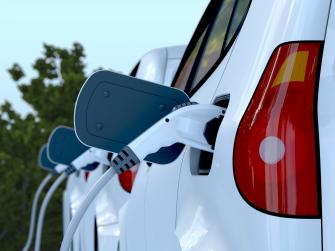Pedal to the metal for electric cars
New rules in California and action by General Motors accelerate timeline for clean cars and trucks.
Quick takes:
- All new passenger vehicles sold in California will be zero-emitting by 2035 and all new trucks and buses could follow suit by 2040.
- GM, America’s largest automaker has called for stronger federal clean car standards.
- California's ambitious actions are paving the way for new national standards that are putting the brakes on gas powered cars.
California announced that all new cars and passenger trucks sold in the state will be zero-emitting by 2035, and more than a dozen other states are expected to follow with similar rules — New York has already started the process. It's a foundational step toward ensuring that 100% of new cars sold in the U.S. could be clean vehicles in just over a decade.
Under California's rules, zero-emitting vehicles include fully electric vehicles, plug-in hybrids and vehicles that get their power from a hydrogen fuel cell.
Nationwide, transportation is the largest and fastest-growing source of climate and air pollution. In California alone, the move is expected to slash greenhouse gas emissions from passenger vehicles in half. And that’s not the only benefit.

“Ending tailpipe pollution from new passenger vehicles will save lives, reduce harmful air and climate pollution, save Californians money and create jobs,” says Andy Su, a clean transportation attorney for the Environmental Defense Fund.
GM ready for new clean car rules
Millions of gas-powered cars and light-duty trucks will still hit the road before 2035, but those vehicles are also going to get cleaner. The Environmental Protection Agency is moving ahead with its next set of vehicle emissions standards — encouraged by America’s largest automaker.
General Motors teamed up with Environmental Defense Fund to call on the Environmental Protection Agency to establish strong new standards that would make at least half of new passenger vehicles nationwide — essentially cars, minivans, SUVs and light pickups — zero-emitting by 2030.
This would drive at least a 60% reduction in greenhouse gas emissions from these vehicles, and dramatically reduce other tailpipe pollution, such as smog-forming nitrogen oxides and lung-and heart-harming particulates.
The EPA is expected to release its new proposed clean car standards in early 2023.
California takes aim at dirty trucks
California is also leading the pack when it comes to cleaning up trucks and buses. While they make up just a small fraction of vehicles on the road, these vehicles have an outsize impact on the climate and on people’s health.
“Taking just one semi-truck off the road is like getting rid of the climate and air pollution from 50 cars,” says Lauren Navarro, a senior manager for EDF's trucks team in California.
California substantially accelerated sales of new electric trucks in 2020 with its Advanced Clean Trucks rule, which directed manufacturers to steadily ramp up zero-emissions truck production. Five other states — Massachusetts, New Jersey, New York, Oregon and Washington — quickly adopted similar rules.
Later this month, California state regulators will vote on the specifics of a new rule that will create demand for these new clean trucks by mandating that commercial fleets of more than 50 trucks and buses, or $50 million in annual revenue, begin transitioning to electric trucks in 2024. That would include everything from Amazon delivery vans to Walmart big box trucks.
A faster timeline for at-risk communities
The proposed Advanced Clean Fleets rule would also set a target date for 100% zero-emission truck sales by 2040. EDF is working with a coalition of environmentalists and environmental justice groups to convince the state to move even faster, and bump that date up to 2036.
What’s more, the proposed rule would also require specific trucks — those that move shipping containers at ports and rail yards — to be free of tailpipe pollution by 2035. Speed is key, as California is home to many of the nation’s largest ports, and communities around them are subject to a steady stream of dangerous diesel exhaust.
Ambitious action by California now can set the stage for new national clean truck standards, which the EPA is expected to release by the end of 2022. Because California and the states that follow its lead make up such a large percentage of the vehicle market, California’s rules can help pave the way for strong national standards.
“We are at a pivotal moment for electrification, and there’s this palpable momentum,” says Navarro. “In terms of stabilizing the climate, in terms of improving human health and saving money — this is a gamechanger.”










